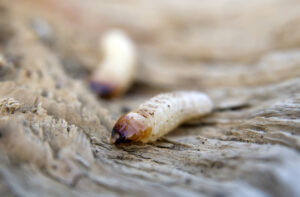Need Help? Call Us On 0161 776 9832 For Expert Pest Control Advice on Identifying Pest Infestations And Help Solve Your Pest Problem.
Woodworm Treatment
 Woodworm is a far more damaging pest than people realise. The infestation could have been happening for years, eating into the very structure of your property. Still, it is only when you acknowledge you have the problem that it can be assessed and the proper woodworm removal treatment used.
Woodworm is a far more damaging pest than people realise. The infestation could have been happening for years, eating into the very structure of your property. Still, it is only when you acknowledge you have the problem that it can be assessed and the proper woodworm removal treatment used.
If in doubt, call or drop us an email for expert pest control advice on identifying pest problems and solving your problem.
Woodworm - identification and treatment
Even the term woodworm is misleading. Woodworm only refers to the woodboring larvae stage of certain beetles. And these beetles differ widely and even prefer different woods, and they require further treatment.
You are unlikely ever to see the woodworm beetles and will probably never see the woodboring larvae that eat their way through your timbers. However, you might be able to spot woodworm damage and the outcome of a woodworm infestation.
*Small holes in the wood, looking like dartboard holes
*Frass, a fine powder sometimes visible around the holes
*Wood edges appearing crumbly and dry
*Tiny tunnels within the wood
*Dead beetles near wood or on windowsills
Even if you think that these signs are of a long-dormant infestation, do not take the risk of further weakening the structure of wooden supports. Get it checked.
This is why it is essentially an expert to assess the species of woodworm, the extent of the woodworm damage, and use the correct treatment to eradicate them. Woodworm removal treatments are effective and safe.
The greatest danger comes from woodworm larvae tunnel into the wood almost unseen, weakening it and any surrounding wooden structures, thus, spreading slowly through joists and floorboards, damaging the structural integrity of your property.
The woodworm life cycle is that of egg, larva, pupa, and adult beetle. Eggs are laid and hatch in cracks in the wood. They then burrow, unseen, inside the wood, greedily eating and tunnelling.
The larval stage is when they burrow into the wood, this stage can last from two to five years. They then approach the wood surface where they pupate just below the surface of the wood and then emerge, leaving the telltale holes as adult beetles between May and September, and the cycle begins again. Woodworm removal treatment breaks this cycle.
The most frequently occurring woodworm infestations are the Common Furniture Beetle (Anobium punctatum). The small round holes can identify the Common Furniture Beetle the larvae leave when emerging, typically 1.5 -2 mm in diameter. The bore dust, which feels gritty when rubbed between the fingers. The adult beetle is between 3 and 5 mm long, and the head resembles monkshood.
The Powderpost Beetle (Lyctus brunneus) prefers the sapwood of tropical hardwoods. It rarely attacks aged timber. The beetle itself is small and dark coloured.
The House Longhorn beetle (Hylotrupes bajulus) cause significant damage because the larvae are so large. Therefore the tunnelling for food and excitement as larvae/adults leaves proportionally so much larger holes. It principally lives in roof timbers where it causes severe structural weakness.
The Deathwatch beetle (Xestobium rufuvillosum) prefers the European hardwood as their breeding grounds, mainly ash, oak, and chestnut. The pupae tunnel to the very centre of the wood, which results in less visible, but far more extensive damage.
Untreated woodworm can lead to structural weakness and even collapse of timbers. Therefore, the proper control treatment must be used.
Many people believe that only older homes can have a woodworm problem. Still, any timber, furniture or wooden structure can be infected with woodworm without noticeable for years. So always check all wood entering the house, are those holes in your new antique dormant, or do you risk infesting other furniture?
The expert needs to identify the exact species involved and see if the woodworm infestation is still active when assessing the woodworm problem. Next, the wood itself and all surrounding timber need to be checked and evaluated to see what has been structurally weakened and, therefore, needs reinforcing or replacing.
Only when the species of woodboring beetle larvae and the extent of the woodworm attack has been accurately assessed and determined can an expert recommendation for control treatment be made.
Property owners, therefore, need a pest identification expert combined with an experienced timber treatment company to ensure that the largely hidden dangers of woodworm are eradicated.
Only a professional woodworm surveyor can assess the full extent of a woodworm infestation. And only an expert can recommend applying the appropriate woodworm treatment and arranging for the replacement or reinforcement of timbers.
So if you think you might have a woodworm problem, then do not hesitate to call us. A complete property survey could find out if there is any woodworm problem, and if there is, we can eradicate the problem with exactly the proper woodworm treatment, one tailored to the species.
